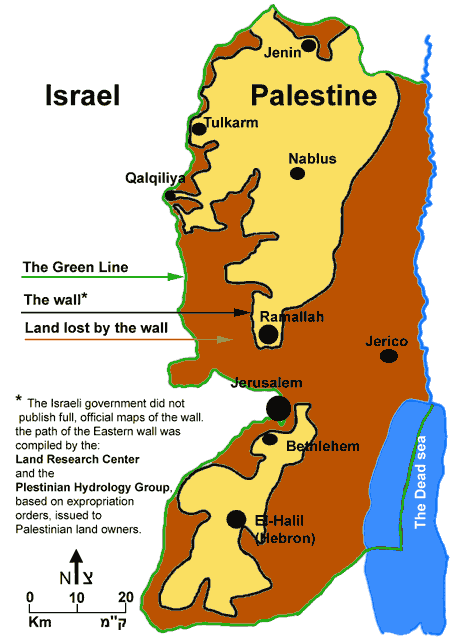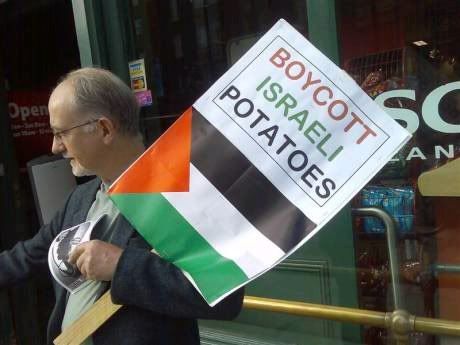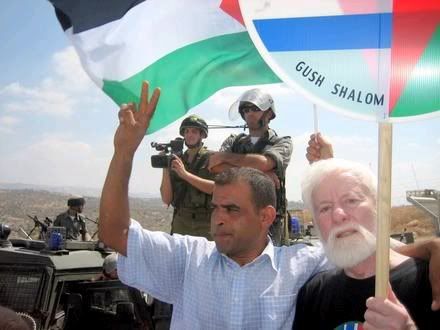
Areas of the West Bank controlled by Israel and the Palestinians. Not shown are the dozens of Israeli only settlements and roads situated in Palestinian areas, which Palestinians do not control.
This Guest Post by Jonathan Wallace: Barriers to a Two-State Solution, appeared on Steve Clemens’ blog, The Washington Note.
One week ago, Steve Clemons wrote a post on this blog involving Zbigniew Brzezinski and Mustafa Bhargouti that discussed Palestinian human rights, and specifically the freedom of movement within the occupied territories. I have been traveling around Israel the past week and spent yesterday touring the Israeli settlements of the West Bank. What follows are my impressions of what I witnessed in the area around Ramallah.
My guide to the settlements of the West Bank was Dror Ektes, an expert on Israeli settlements in the West Bank who heads efforts to challenge the illegal seizures of Palestinian land in the Israeli court system for the human rights organization, Yesh Din.
I was shown numerous Israeli settlements in the area. Some were for orthodox Jews only, while others were secular in nature. Some would not look out of place on Main Street, USA. As we drove deeper and deeper into the territory, the settlements became more Spartan and heavily fortified. Illegal outposts or “pre-settlements” dot the hills of the territory. Most of all, I noticed the fences. Everywhere, there were fences, checkpoints and razor wire, marring a would-be picturesque geography. The fences stretched all the way from the top of the hills down to the roads in the valleys. While the fences enclose the settlements, they also serve another purpose; they often block Palestinian access to their own private property.
Settlements (or outposts) such as Ofra and Migron use fences to appropriate land from Palestinians in an extrajudicial manner, thus allowing the Israeli settlers to expand their settlements on land that was not given to them by the State of Israel.
As I traveled through the West Bank, and moved from settlement to settlement with my guide, it became clear that the infrastructure, built by the Israeli State, was actively working against a two-state solution. Israeli-only roads were built between settlements, but had the effect of bisecting the West Bank and isolating many Palestinian communities from their larger villages or towns. Since I was in a car with Israelis, we were able to take the Israeli-only Highway 443 that had been built on what used to be private Palestinian land. My guide explained that these roads, built for the convenience of Israelis, disrupt or completely sever Palestinian transportation and is one way that the settlers/state try to marginalize the 90% of the West Bank population that is Palestinian. A Palestinian state in the West Bank may be still-born if it cannot ensure freedom of movement for its citizens and property rights which are basic functions of a state.
The de facto borderlines, fences, and walls that have carved the West Bank since Oslo have created a situation, which increases the friction among Israeli settlers, the state of Israel and Palestinians. In response to further and further incursions by religious and secular settlements, the Israeli State has acted in a manner that is both unfair and humiliating toward the Palestinian population in the West Bank. By building more security fences, checkpoints and Israeli-only roads on Palestinian land, Israel encourages the imagery of occupation and apartheid.
The current policies only seem to reinforce Palestinian humiliation, galvanize extremists, and undermine the democratic character of the Israeli state. In the end Israel, being pushed by a vanguard of zealot settlers, is creating facts on the ground that may make a Palestinian state that includes the West Bank impossible to achieve.
A balkanized West Bank, with Palestinians separated from one another by Israeli roads, fences, and checkpoints, will increase Palestinian marginalization and eventually lead to violence against those that perpetuate the occupation. It is an under-publicized impediment to peace, but it may prove to be a lasting one.
— Jonathan WallaceReprinted by permission.
Praise to those Israelis who know right from wrong in the context of a liberal democracy, which Israel has not quite attained.
How can you help stop the human rights injustices on the West Bank? Do what these guys and gals are doing!

Boycott by a member of the Ireland Palestine Solidarity Campaign.

A nonviolent protest in the West Bank town of Bi’lin.

A contingent of protesters in front of a synagogue in Michigan.

A protest for Palestinian rights in Central Park, New York City.




